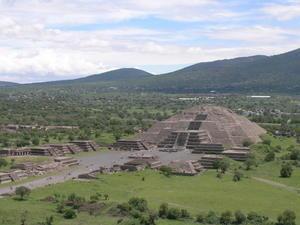Advertisement
Published: June 26th 2006

 general view
general view
The largest temple is the temple of the moon, taken from the top of the temple of the sun.OK heres part one of an entry on our weekend trip to Mexico City. On Saturday, we drove straight to the ruins of an indigenous town. It was absolutely intriguing! We had a tour guide named Oscar who knew tons of facts about the place and spoke some Spanish, some English during the tour.
Here is the down low on the ruins: the were actually first created by an ancient culture, older than the Aztecs, and then later discovered and inhabited by the Aztecs. So, all of the names and theories come from the Aztec beliefs, but could have been different for the original culture. All that is left of the pyramids are the bases. The were created from a light type of rock that is from volcanoes and plastered together with a mixture of lime, water, and cactus milk. Nearly 80% of the city is believed to have been painted. The paint was primarily red and made from a worm that lives in the cacti.
The pyramids were used to worship the many gods of the indigenous religions. Although all that is left is the base, there were temples and intricate carvings all around the sides. The primary

 orignial paintings
orignial paintings
These haven´t been touched up at all! You can kind of see a parrot looking bird (green head) which is a symbol of fertility.two are for the Sun and the Moon. The sun was central to the culture because in brought life in the form of crops. Therefore, this temple in all indigenous tribes is built facing the east.
The other smaller bases were houses of the upper class people, such as priests or governors. We went into the Temple of the birds, which housed many priests, and there still remains some beautifully preserved paintings. There are many symbols of birds, flowers, water as this temple was dedicated to the fertility of the land.
Scrambling up the pyramids was a blast! The steps are at times very high and steep, some came up to my knees! Our tour guide said this is because the indigenous people climbed them sideways so as not to turn the back to the temple of the god. He also said this causes you to hunch over while climbing, a sign of respect.
All along the way there were people trying to sell us stuff, small clay flutes, bracelets, masks, you name it. It is very interesting to think that these people are quite possibly the descendants of those who lived in these pyramids. The result

 looking for customers
looking for customers
One man along the road with goods to sell.of their culture being over taken by Spain has made life a struggle in the ¨modern world.¨
Another fun tidbit,we visited on June 24, which is the day of Saint John. When the spaniards came over and converted the indians to catholicism, they also converted the many gods of indiginous religions to saints. The rain god, Tlaloc, was converted into St. John. Our tour guide very calmly toldus that it would rain sometime today. Sure enough, just as we were headed to the hotel, it did!
Advertisement
Tot: 0.126s; Tpl: 0.01s; cc: 12; qc: 54; dbt: 0.0704s; 1; m:domysql w:travelblog (10.17.0.13); sld: 1;
; mem: 1.1mb

 general view
general view
 orignial paintings
orignial paintings
 looking for customers
looking for customers
Aunt Lish
non-member comment
This is Blog thingy is cool. It has been fun staying up to date with all of your adventures. I'm looking forward to Durango to hear even more. However, you will need to switch back to the English language when communicating with us wee little Kansans.